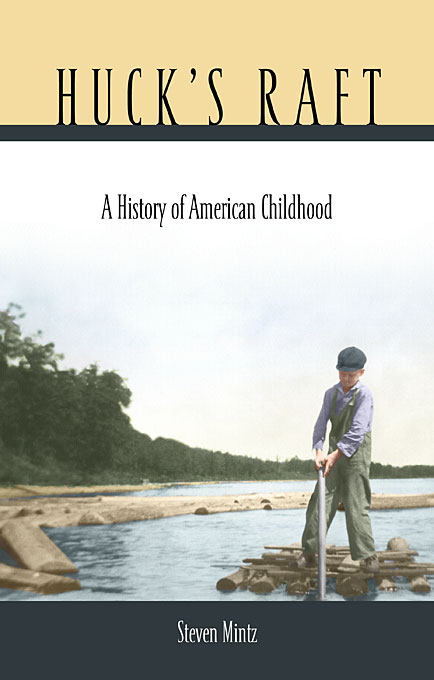“Kids today.” Everyone says it, it seems, in reference to the idea that children today are spoiled, raised with poor values, and somehow have it worse than their parents generation. This notion dominates discussions from political debates to stand up comedy acts. But, what defines the stages of life and how people are supposed to act in each? Has it always been that way?
Steven Mintz has long been interested in the transformations of family life through the ages and, in this episode, talks about how nearly everything we think we know about family life would be unrecognizable even a century ago.
Guests
 Steven MintzProfessor, Department of History, University of Texas at Austin
Steven MintzProfessor, Department of History, University of Texas at Austin
Hosts
 Joan NeubergerProfessor of History, University of Texas at Austin
Joan NeubergerProfessor of History, University of Texas at Austin
How did you get interested in the history of the family?
Everything that I write grows out of my personal interests and personal needs.
When I was starting my own family and discovered how difficult it was, I wanted to put it in some kind of perspective. And that meant looking over centuries of time, not just decades of time, and what I’ve learned is that families have gone through a series of far reaching transformations–Domestic Revolutions I called them–in which everything changes. The size, the structure, the emotional dynamics, the power dynamics, the roles that individuals play, everything changes. One thing that’s obvious to me is that the incredible changes that have taken place in family life over the past decade are only the most recent of a long series of domestic revolutions.
Today we’re going to focus on the history of childhood. One of our core social beliefs is that childhood determines what happens the rest of your life. Is that a universal belief or is that an American-European idea?
It is remarkable how recently the idea that childhood is the critical stage, that “the child is the father of the man,” as the poet Wordsworth put it, that is a really remarkably recent notion. If you take a look at the book Tom Jones by Henry Fielding, one of the first lines in the book is about the first ten years of my life, nothing much happened.
And that was the late eighteenth century?
Correct. And that belief that childhood was utterly insignificant was a long held view and so it makes us distinctive, it makes us unique, it makes us fundamentally different than our ancestors.
Was Freud the main reason that this changed? How did Freud contribute to this or was it a gradual change?
It is certainly a gradual change. It’s a change that really begins in the late 17th c when John Locke, the English philosopher, likens children to a ball of wax that could be shaped in any form for good or evil. And then later Jean-Jacques Rousseau, the French philosophe, argues further that children are innocent, purer, wholer than adults and that as we mature we lose certain magical properties that are embedded in children. So Rousseau turns the notion of maturation on its head and instead sees maturation as a kind of falling away from primal innocence, purity and really a sense of wonder.
One of Freud’s great insights is that Rousseau was wrong. Children are not pure. Children are not innocent. Rather, children are seething cauldrons of instinctual impulses and in Freud’s view much of what parenting and child rearing is about is taming those instincts and socializing a child to be able to fit into adult life.
And that this is a very difficult process. That view of childhood is a view that many Americans wouldn’t accept. It’s a harsh view, many would find it even a kind of punitive view of children. And yet I think every parent knows at some level that for all the joys and wonders and playfulness of childhood, there’s also a kind of willful spirit that needs to be guided, not repressed, in order for that child to really be able to tap into all of her or his potentialities.

And ideas about how to create that environment–I’ve watched them change as my own children have grown up several times actually in the last couple decades. We put a lot of pressure in the US on nuclear families to provide the “right “ environment. How has that changed?
I am a product of the 1950s and early 1960s and for many Americans, for baby boomers and their parents this was the Golden Age of American childhood. You didn’t have to look to the mythic path to see the Golden Age. You could see it right in suburban backyards where kids were engaged in free, unstructured play and could
roam through fields and streets without much adult interference. And for many baby boomers and their parents, this is the ideal of childhood and one that we’ve fallen away from because obviously growing up is quite different. Kids spend a lot more screen time, not just television sets but in front of video games and cell phones and the like. The geography of childhood has narrowed.
As families have gotten smaller and as birth rates have plummeted, there are fewer kids to socialize with. On the block where I raised my kids there had been a hundred kids during the 1960s and there were two kids in the 1980s: quite a change in the actual experience of childhood. But don’t let any of this suggest that childhood has gotten worse, it just has changed in really fundamental ways.
There was a bleak side to childhood in the 1950s: the constraints placed upon girls, the invisibility of children with disabilities. And there is a positive to childhood today: the knowingness of children, the ability to connect to other kids electronically. These are real gains. So we have to be very balanced, I think, in assessing the direction of historical changes.
One of the things that has changed is what people think about the structure of the family. When we were growing up in the 1950s and 60s there was the ideal of the nuclear family with one mother and one father and there are still a lot of people in the US who think that that’s the best way to raise children. But certainly structures have become more flexible if only very recently. A lot of people think it’s just fine to have two mothers or two fathers or one mother or one father. Are those ideas new or was there always a lot more variety in the American family that the sitcoms from the 1950s made us think?
There has long been a view in this country that childhood is going to hell in a handbasket.
No matter what?
No matter what!
And that’s been a constant refrain from time of Puritans on to the DVD generation of our own era. And yet that is profoundly misleading. Take the example of single parenthood. Or children growing up with only one parent. In 1900 about 10 % of children lived in single parent homes. And that’s not all that different than the situation today. The causes were different. That is, in 1900 the causes were not divorce but rather premature death or abandonment. But the experience was not fundamentally different. We must be very careful about not viewing the past through rose-colored glasses or sentimentalizing the experience of earlier generations. It’s far more complicated than that.
So, for example, because we would like to think that children ought to be protected in some way today in a stable, secure environment, history shows — not just history but today — many children don’t live in a stable, secure, carefree environment, that 20% of children live in families under poverty line. How do we as a culture incorporate that into our ideas and our policies about childhood? Do we just ignore it generally or what are we doing?
One of the pivotal turning points in the history of childhood was the growing recognition—it began in the 18th century but didn’t really climax until well into the 20th century–a view that we have a collective responsibility to all children not just our own children and that is because children are fragile, vulnerable creatures who represent our collective future. And indeed I would argue that much of the American welfare state emerged precisely in order to protect children. But again what’s shocking is how long it took for this idea to develop. If you read nineteenth-century autobiographies, you will discover that in virtually every autobiography children were whipped with a belt or some other implement. It’s just utterly shocking to us. This wasn’t unusual, this wasn’t abnormal, this was normal experience. Or it is also shocking to discover that child abuse was not a crime in the United States before the 1870s and 1880s; or that child labor was permitted in the United States until 1938.
We discover that this sense that we have a collective responsibility for children is a really recent development and, I should add, not one that is complete. Because often we view children who are different from us in some way–that is, poorer than us, a different ethnic group than us, a different skin color–we view those children as outside our obligation and hopefully in the future we will indeed see that all kids are “my” kids.
Would you say that the US is a particularly child-friendly society compared to other countries? This is something I often run into when I visit Russia. People like to ask if Russia seems particularly child friendly, they think they are.
It depends, of course, on how you calculate this. No other society spends as much money on toys for children. No other society spends as much money on education for children. No other society spends as much money on healthcare for children. And no one spends more money on juvenile justice programs for children.
In other words, the United States has deep ambivalence about kids. That is, we are fond of their playfulness, their energy, but many adults like to live in areas where they don’t have much contact and of course we don’t take kids to our workplaces because that’s viewed as inefficient. And ours is a society with really intense age segregation. And so most kids have very little interaction with adults, except adults who are paid to interact with kids. And most kids have little dealing with adults other than their parents, maybe a few aunts and uncles. We are a very generationally segregated society and in my own view that that makes it all that much more difficult to grow up.
Speaking of difficulties growing up, have our notions about juvenile crime changed over the course of the century?
You can learn a lot about history by going to the movies.
And if you look at the treatment of children in movies over the past 100 years it is really shocking and not what you would expect. That is, in the early 20th c the most popular, highest paid actor in America was Mary Pickford. Mary Pickford got older in real life but she got younger on the screen. And she played characters like Little Annie Rooney, who was what we used to call a tomboy, who would fight and run and adult loved her. And during the Great Depression people loved The Little Rascals and they loved a group of juvenile delinquents called The Dead End Kids. And, again, back then there was this love of children as freer than adults, more in tune with their feelings and impulses, and that was a great thing.
And then, beginning in the 1950s with movies like The Bad Seed or Rebel Without a Cause but really intensifying in the 1970s with Taxi Driver where Jodie Foster plays a 12 year old prostitute or Carrie who’s possessed by the devil, you get a much more negative depiction of children. And if movies really speak to our fantasy world what they suggest to us is that this is a country that doesn’t much like kids but actually fears kids.
You also write that Americans tend to think either that things get a lot better or a lot worse. Do you think that there is progress in the state of childhood, are we doing a better job at protecting children from child abuse or child pornography or being victims in some other way?
We’ve lived through a revolution in childhood. More children are growing up in single parent homes, more children are experiencing divorce and this has produced a great deal of fear among many adults: a feat that this is damaging children psychologically and will have all kinds of terrible repercussions on our society.
But in fact by almost every measure kids are doing better than ever. They’re graduating from high school at higher rates. Fewer kids are smoking. Even the age of first intercourse is getting a little later than it was in the early 1970s. Crime rates are at their lowest levels since the early 1960s. So by all those measures kids are way better off than they used to be.
And yet I would argue that it’s always more complicated than “progress” or “decline” could ever lead us to imagine. Take the example of children’s health.
Child mortality rates are the lowest ever and this is a huge success. And yet it is also true that more kids suffer from chronic illnesses and more kids suffer from disabilities than at any other time in history. This paradox is easily resolved – kids would have died earlier, right? But it suggests a paradox that we have to cope with.
And, furthermore, we know that in our society there is a deep divide between the experience of wealthier kids and their poorer counterparts. The amount of investment that more affluent parents can make in their children’s lives–investments in money, in enrichment activities, even in time–is hugely different than what poor parents can afford. It’s not they don’t want to. It’s that the economic conditions of their lives — the stresses, particularly the financial stresses — make it impossible. And so as in this area as in so many areas, when we ask are things getting better, we have to ask for whom and in what dimension of life?
Historians always like to complicate things by looking at the whole picture. Thank you very much, Steve.
Thank you very much for inviting me.